Sacred groves in tropical landscape
Sacred groves are socio-culturally protected vegetation patches dotted in the 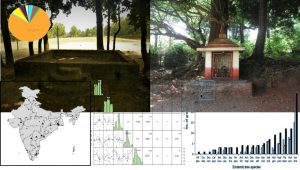 tropical landscape. They represent diverse cultural, social and religious association of the communities with the landscape. This nature conservation tradition can be considered as a time tested model to study the multiple facets of human association with natural world. This project aims to explore the role of sacred groves in natural resource conservation, ecosystem services, functional biodiversity maintenance, local livelihood improvements and as an important landscape component.
tropical landscape. They represent diverse cultural, social and religious association of the communities with the landscape. This nature conservation tradition can be considered as a time tested model to study the multiple facets of human association with natural world. This project aims to explore the role of sacred groves in natural resource conservation, ecosystem services, functional biodiversity maintenance, local livelihood improvements and as an important landscape component.
Socio-Cultural History of Old Trees
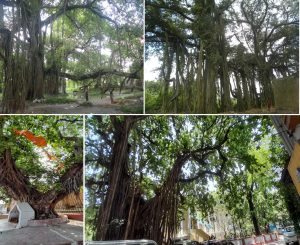 Ancient trees are unpolished rustic jewels of any landscape whose presence mesmerizes us, assures us of countless services, and entangles us with nature irrespective of time and place. Despite their intimate association with our lives, there are limited systematic studies to understand their role in the social-cultural-religious milieu of society.
Ancient trees are unpolished rustic jewels of any landscape whose presence mesmerizes us, assures us of countless services, and entangles us with nature irrespective of time and place. Despite their intimate association with our lives, there are limited systematic studies to understand their role in the social-cultural-religious milieu of society.
Our exploratory survey in Gangetic West Bengal documented 160 such old trees amidst versatile landscape features. They are standing alone either near the places of worship, near the village waterbody, along the roadside, near the deserted house, inside the school premises, at the center of the village market, and so on. Most of these trees are protected or cared for under religious norms (~35% of the documented members). Likewise, they are part of the rural social life due to their presence at the places of human interaction. People enjoy their presence and acknowledge their services yet are reluctant to be serious about their management and protection. This pilot study shares information about trees’ presence, their interaction with the localites, the challenges they face, and a few possible steps that we can take.
Interested to know more? Go for Ancient Tree: Our Living Heritage, The Green Forefathers of Kolkata Maidan, Old Trees in Our Time.
Wild edible food diversity
From an enormous diversity of one third of a million flowering plant species on this earth, around 20-30% are palatable and edible. In contrast, nearly twenty domesticated species supply up to 85% of the world’s food base; of which three, rice, maize and wheat, are primary cereals make up nearly half of the world’s calorie intake. However, uncultivated, wild and minimally managed edible food is still an important source of nutrition for a large fraction of ethnic, rural, and semi-urban societies across cultures. 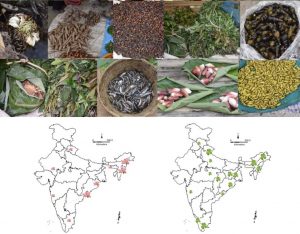 It indicates, despite globally dominant food culture and over-dependence on selected set of crops, the acceptance of wild food is vibrantly alive to this day. India is a country of immense bio-cultural diversity and consuming wild edible flora is ingrained in our culture. More than thousand species are eaten as leafy vegetable, fleshy fruit, underground parts, flower, and seeds, but little is known about the general pattern of use. We, in this project, set out to explore the spectrum of wild food diversity and their pattern of use. We also intend to disseminate the knowledge with an aim to sensitize.
It indicates, despite globally dominant food culture and over-dependence on selected set of crops, the acceptance of wild food is vibrantly alive to this day. India is a country of immense bio-cultural diversity and consuming wild edible flora is ingrained in our culture. More than thousand species are eaten as leafy vegetable, fleshy fruit, underground parts, flower, and seeds, but little is known about the general pattern of use. We, in this project, set out to explore the spectrum of wild food diversity and their pattern of use. We also intend to disseminate the knowledge with an aim to sensitize.
Sustainable Agriculture
Wisdom from Traditional Ecological Knowledge (TEK) may often play an important role in developing sustainable agriculture practice. Catching fish and other aquatic fauna 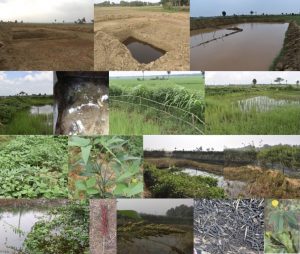 in rice fields has been an age-old culture among many Asian countrymen. Ranging from south, south-east to east Asia, it is still in vogue; it has also become relatively organized in many countries and emerged as a successful production system that enabled sustainable intensification. Coupling indigenous catfish and deep-water rice landraces, we would examine the viability of the co-cultivation system in terms of production, its agro-ecological underpinnings, and its role in sustainable livelihood generation.
in rice fields has been an age-old culture among many Asian countrymen. Ranging from south, south-east to east Asia, it is still in vogue; it has also become relatively organized in many countries and emerged as a successful production system that enabled sustainable intensification. Coupling indigenous catfish and deep-water rice landraces, we would examine the viability of the co-cultivation system in terms of production, its agro-ecological underpinnings, and its role in sustainable livelihood generation.
Biodiversity, food, and culture
Elements of biodiversity, both flora and fauna, have an inspiring effect on the realms of art and culture, be it as motifs and symbols in paintings, sculptures, smaller 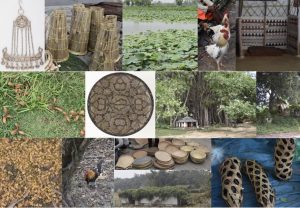 household art objects, or as metaphors or protagonists in folktales, oral traditions, or on the foundation of our existence, i.e., food. We wish to understand the nexus by collating and documenting its inklings scattered in the domains of ethnobiology, anthropology, folk art, older texts, history, archaeology, and oral traditions. We seek to analyze it to interpret how all these living forms influence our aesthetic sense and have an overarching impact on our biological, cultural, mental well-being.
household art objects, or as metaphors or protagonists in folktales, oral traditions, or on the foundation of our existence, i.e., food. We wish to understand the nexus by collating and documenting its inklings scattered in the domains of ethnobiology, anthropology, folk art, older texts, history, archaeology, and oral traditions. We seek to analyze it to interpret how all these living forms influence our aesthetic sense and have an overarching impact on our biological, cultural, mental well-being.
Dialogue between two worlds: an attempt to mend epistemic bonds
Forest and Adivasi Women: a different way of making connections
